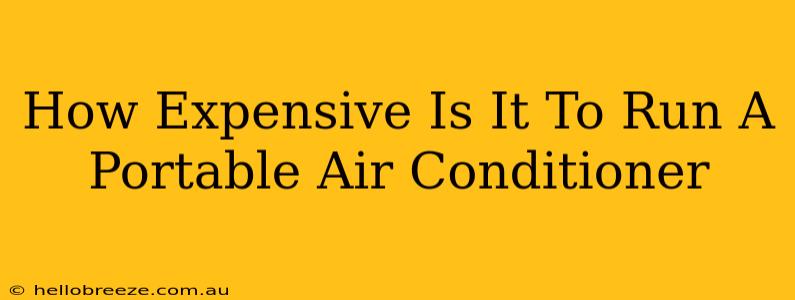Summer heat can be brutal, and a portable air conditioner offers a tempting solution for staying cool. But before you rush out to buy one, it's crucial to understand the cost of running it. This guide breaks down the factors influencing the energy consumption and ultimately, the expense, of operating a portable AC unit.
Factors Affecting the Running Cost of a Portable AC
Several key factors determine how much it will cost you to run your portable air conditioner:
1. Energy Efficiency (BTU/h and EER):
The most significant factor impacting running costs is the unit's energy efficiency. Look for the British Thermal Units per hour (BTU/h) rating, which indicates cooling capacity. Higher BTU/h means more powerful cooling but also higher energy consumption. Equally important is the Energy Efficiency Ratio (EER). A higher EER indicates better efficiency; more cooling per watt of electricity used. Look for units with a high EER rating to minimize running costs. Generally, an EER of 12 or higher is considered efficient.
2. Size of the Room:
Using a portable AC that's too small for the room will struggle to cool it effectively, leading to longer run times and higher energy bills. Conversely, an oversized unit might cycle on and off frequently, wasting energy. Choosing the right BTU/h rating based on the room's square footage is critical for optimal efficiency.
3. Climate and Ambient Temperature:
The hotter the outside temperature, the harder your AC has to work, leading to increased energy consumption. Expect higher running costs during extreme heat waves.
4. Usage Habits:
How often and how long you run your portable air conditioner significantly affects the overall cost. Setting the thermostat to a reasonable temperature (around 78°F or 26°C is often recommended) and using it only when necessary can make a considerable difference. Consider using it strategically, like only during peak heat hours or when you're home.
5. Electricity Prices:
Your electricity rates are a direct factor in the final cost. Check your electricity bill to determine your per-kilowatt-hour (kWh) rate. Higher rates will result in higher operating costs.
Calculating Your Estimated Running Costs
To estimate your running costs, follow these steps:
-
Find your AC's power consumption: This information is usually found on the unit's label or in the user manual, typically measured in watts (W).
-
Convert watts to kilowatts: Divide the wattage by 1000.
-
Determine daily usage: Estimate how many hours you plan to run the AC daily.
-
Calculate daily energy consumption: Multiply the kilowatt value by the daily usage hours.
-
Calculate the daily cost: Multiply the daily energy consumption by your electricity price per kWh.
-
Calculate the monthly cost: Multiply the daily cost by the number of days in the month.
Example:
Let's say your portable AC consumes 800W (0.8kW), you run it for 8 hours a day, and your electricity costs $0.15 per kWh.
- Daily energy consumption: 0.8kW x 8 hours = 6.4 kWh
- Daily cost: 6.4 kWh x $0.15/kWh = $0.96
- Monthly cost (30 days): $0.96 x 30 days = $28.80
Keep in mind: This is a simplified calculation. Actual costs may vary depending on the factors mentioned above.
Tips for Reducing Running Costs
- Regular maintenance: Cleaning the filter regularly improves efficiency and extends the lifespan of the unit.
- Proper installation: Ensure proper ventilation to allow for efficient heat exchange.
- Smart thermostat: Consider using a smart thermostat to optimize energy usage.
- Insulate your home: Improved insulation reduces the workload on your air conditioner.
- Use fans strategically: Combining fans with your AC can allow you to raise the thermostat temperature while maintaining comfort, saving energy.
By understanding these factors and using energy-saving strategies, you can enjoy the benefits of a portable air conditioner without breaking the bank. Remember to research and compare models with high EER ratings to find the most cost-effective option for your specific needs.

